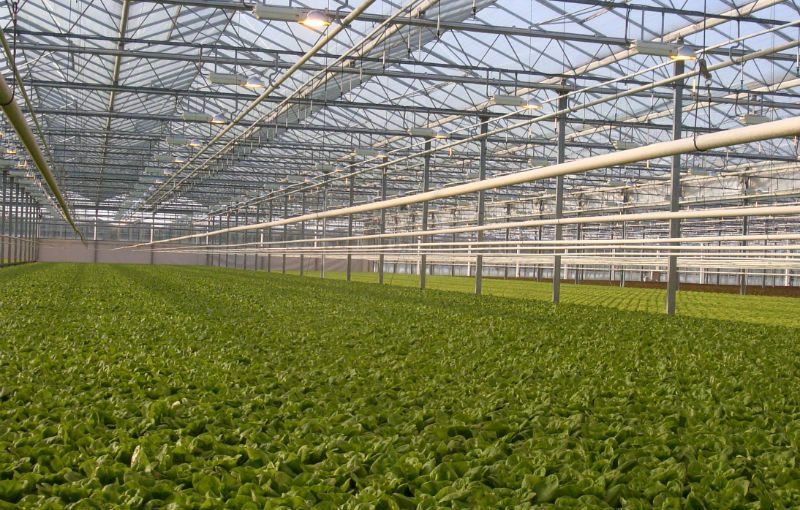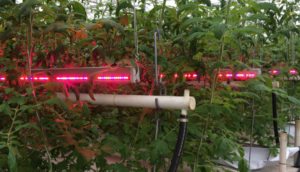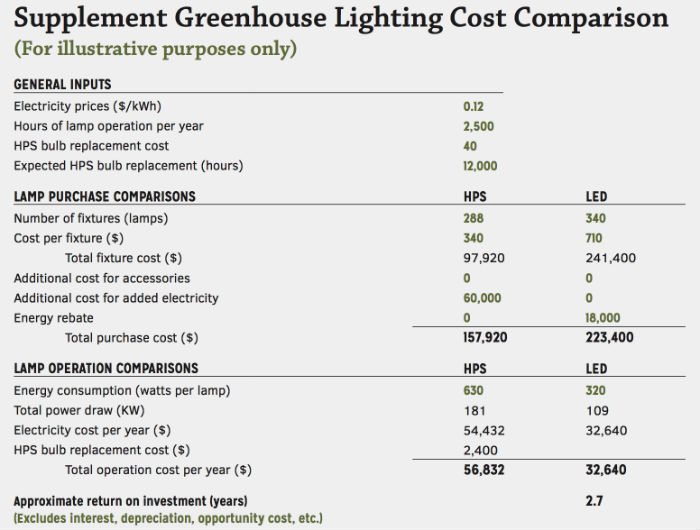
Investment Considerations for Greenhouse Lighting
The yield of greenhouse vegetables is largely driven by the amount of photosynthetic light provided to plants. As radiation increases, plant biomass increases, resulting in greater fresh weight of leafy greens and more and larger harvestable fruits.
However, in many parts of the United States, light is a limiting factor in greenhouses during the winter. Therefore, many growers install and operate supplemental (photosynthetic) lighting to increase crop quality and yield, especially for the darkest, shortest days of the year. This article describes some of the factors to consider when investing in a supplemental lighting system for greenhouse vegetable production.
Daily Light Integral
The daily light integral (DLI) refers to the cumulative amount of photosynthetically active radiation (400 to 700 nm) received each day. The DLI unit is moles of photons per square meter and day, or mol·m⁻²·d⁻¹.
The DLI inside greenhouses varies dramatically, depending primarily on the time of year, location of the greenhouse, and greenhouse light transmission. The recommended DLI varies among crops as well as other environmental parameters and desired quality characteristics. Generally, plants can use higher DLIs (such as >15 mol·m⁻²·d⁻¹) when the greenhouse is enriched with carbon dioxide and/or when temperature is slightly increased. Therefore, supplemental lighting installation and operation should consider other environmental factors — as well as cultural ones — to maximize plant responses and thus, economic returns.
Lighting intensity. Determine the average solar DLI you receive inside the greenhouse, and then what intensity of electric lighting is needed to reach the target DLI. A target DLI for lettuce, leafy greens and herbs, and other non-vining vegetable crops is usually 14-18 mol·m⁻²·d⁻¹ (Figure 1 (pictured above). A target DLI for high-wire fruiting vegetables such as tomato and cucumber is at least 25-30 mol·m⁻²·d⁻¹. To reach these DLIs, a supplemental light intensity of 60 to 100 μmol·m⁻²·s⁻¹ is common for moderate-DLI crops, while 150 to 200 μmol·m⁻²·s⁻¹ is common for high-DLI crops.

If you don’t have DLI data or know what lighting intensity to provide, these can be estimated based on the average DLI delivered outdoors, the light transmission percentage of your greenhouse, and the target DLI. For example, in mid-Michigan, the average outdoor DLI during the darkest three months is around 10 mol·m⁻²·d⁻¹ (Figure 2). If a greenhouse transmits 65 percent of that light, then the greenhouse DLI is around 6.5 mol·m⁻²·d⁻¹. If your target DLI is 14 mol·m⁻²·d⁻¹, then 7.5 mol·m⁻²·d⁻¹ needs to be delivered from supplemental lighting. If you plan to operate lamps 20 hours per day, then the required intensity needed can be calculated as: 7.5 mol·m⁻²·d⁻¹ × 1,000,000 μmol·mol⁻¹ ∕ 20 h·d⁻¹ ∕ 3,600 s·h⁻¹ = 104 μmol·m⁻²·s⁻¹.
Hours of lighting per year. Environmental control computers typically track the hours that lamps operate each year. This information is important when making investment decisions, because the more lamps operate each year, the faster the return on investment with more expensive but more energy-efficient lighting fixtures. If you don’t have data already, you can estimate this number each month once you know your solar DLI, the target DLI and desired supplemental lighting intensity.
Electricity rate ($ per kWh). As with hours of lamp operation, this value is important when considering different lighting technologies. A return on investment is quicker for more energy-efficient fixtures for operations that have a high electricity rate.
Electrical capacity. Having to increase your supply of electricity can be very expensive and change investment decisions for greenhouse lighting. More energy-efficient fixtures could be worth a greater price premium if less efficient fixtures would require additional power to your greenhouse.
Lighting plans. Work with several lighting companies to obtain lighting plans and price quotes to deliver the intensity (in μmol·m⁻²·s⁻¹) calculated to meet your target DLI. Be sure to include the costs for any needed accessories, including wiring and labor for installation. You will need to provide lighting suppliers with information about your greenhouse, including its dimensions and viable distances between the fixtures and the top of the plant canopy. Also, ask your utility company about whether any rebates are available for more energy-efficient fixtures.
Scrutinize the lighting plans, especially the variability in light intensity. The more uniform the intensity, the more uniform the crop. A target uniformity value is 15 to 20 percent or less. For example, if your goal is to deliver 110 μmol·m⁻²·s⁻¹, the desired delivered intensity range is within 100 and 120 μmol·m⁻²·s⁻¹.

Lamp Characteristics
When selecting the appropriate lighting options for your growing operation, there are several different lamp characteristics to consider.
• Other than durability, probably the most important aspect to consider is the efficacy of the fixture. This value quantifies the number of photosynthetic photons emitted per watt of electricity, and is in the unit of micromoles per joule (μmol·J⁻¹).
Most major lighting companies are now reporting these values, and range from 0.9 μmol·J⁻¹ for 400-watt high-pressure sodium (HPS) fixtures with magnetic ballasts, to 2.0-2.7 μmol·J⁻¹ for modern LED fixtures. An LED with an efficacy value of 2.7 μmol·J⁻¹ means it emits three times the amount of photosynthetic light as 400-watt HPS lamps per watt of electrical input.
• Limited research has been performed about how the light spectrum influences plant growth in greenhouses, but generally the spectrum of supplemental lighting has relatively little effect on growth or yield. There are some exceptions however, especially when the solar DLI is very low (<5 mol·m⁻²·d⁻¹), and supplemental lighting provides a majority of the total DLI available to plants.
• Many horticultural LEDs consist of blue and red diodes, which create a purplish-pink light. Some people find it challenging to work under this color of light, so consider people as well as the plants when choosing a light spectrum. An LED fixture with even a small number of white LEDs can create a more pleasant working environment.
• Most crops are lighted from overhead, although for vertically growing crops such as tomato, lamps can be positioned within the canopy, which is known as inter-canopy lighting (Figure 3). Fruit yield is generally similar whether provided with only top lighting or a mix of top and inter-canopy lighting, assuming the total light delivered to crops is similar.
• Lamps should be as small as possible so they don’t cast much shade to crops below. Therefore, consider the number and surface area of lamps needed to deliver your desired light intensity, keeping the lamp footprint to a minimum.
Cost to operate lighting systems. Once you have the number of fixtures and their electrical draw (including ballasts for HPS lamps), you can estimate the total energy consumption and cost. Also consider any needed maintenance costs for different lamp options, such as replacement of HPS bulbs.
Effects on plant temperature. Some of the inefficiency of HPS lamps (the amount of electricity converted into heat) can be useful during the winter. Plants are often 2 to 3° F warmer under HPS lamps than LEDs, so heating inputs may have to slightly increase when growing under LEDs than HPS lamps.
Quality control. Regardless of lamp type or supplier, there will probably be some fixture failures, so obtain information about lamp guarantees or warrantees. Also, after a lighting system is installed, check that the intensity delivered is what you purchased. How will the company respond if the intensity is less than what was in the lighting plan?

Putting the Pieces Together
Once you have considered your lighting options and obtained quotations for different lamp types, create a spreadsheet to compare purchase and installation costs and costs of operation. A simple example is provided in Figure 4.
Here, comparisons are made between a 600-watt HPS lamp and a 320-watt LED, and are provided for illustrative purposes only. Values with a yellow background were entered whereas those with a white background were calculated from the entered data. The number of lamps, cost of lamps, etc. were provided by companies based on delivery of the same light intensity.
In this case, the supply of electricity at the hypothetical greenhouse is limiting, so an additional cost is incurred for installation of the HPS lamps. In addition, the cost to install the two options was assumed the same and was not included, but this may not be the case for your greenhouse. Values are highly situational, which is why every operation needs to perform their own calculations. Some lighting companies can help you with this analysis.
Additional information: This article highlights some of the major factors to consider when investing in a lighting system. For more information on greenhouse lighting, visit the Michigan State University Floriculture website: http://flor.hrt.msu.edu/lighting.
Another useful resource is the 2017 book Light Management in Controlled Environments, which contains 18 chapters written by leading lighting experts and is available for purchase through Amazon.com.
Erik Runkle is professor and floriculture extension specialist in the department of horticulture at Michigan State University. He can be reached at runkleer@msu.edu.


 Video Library
Video Library 




















